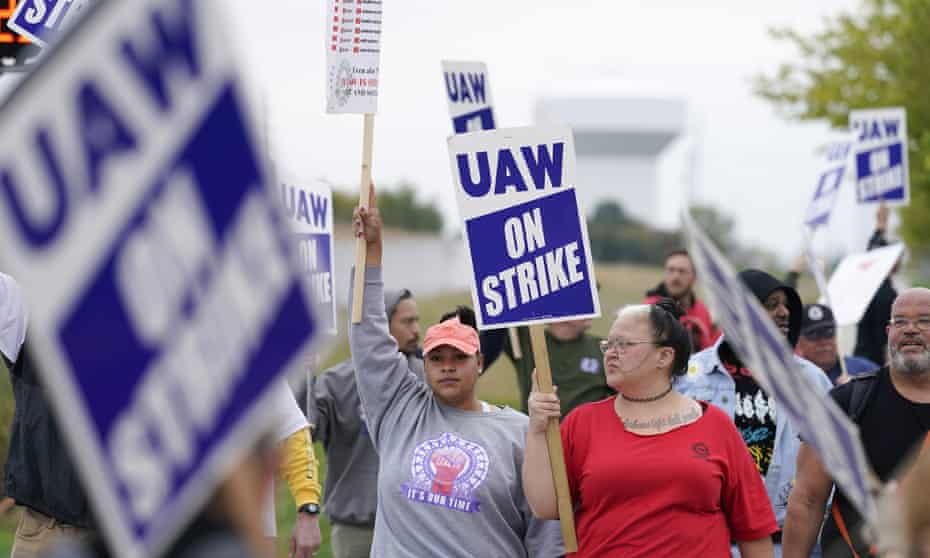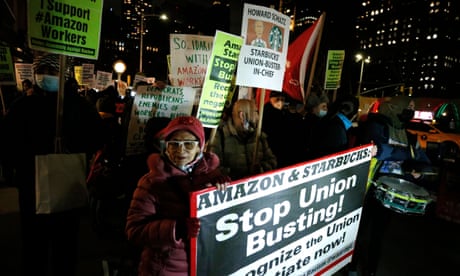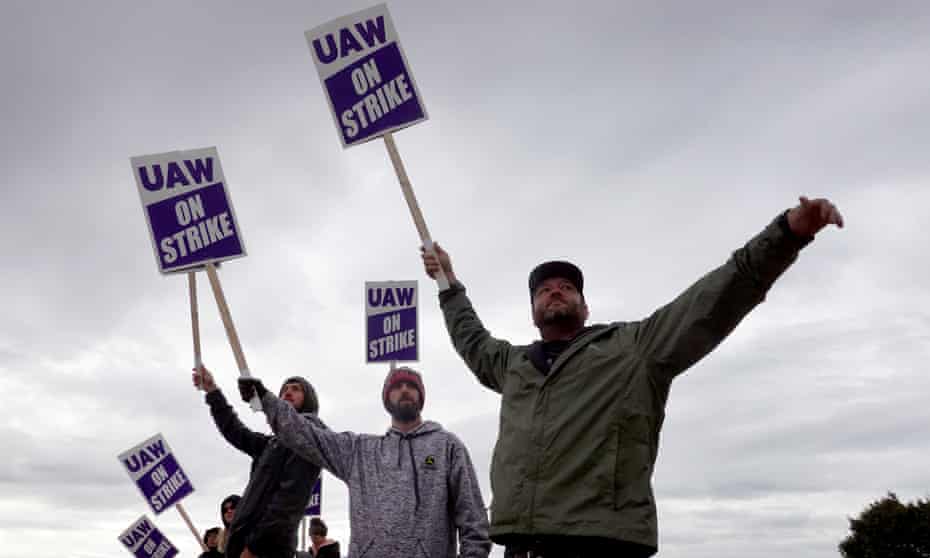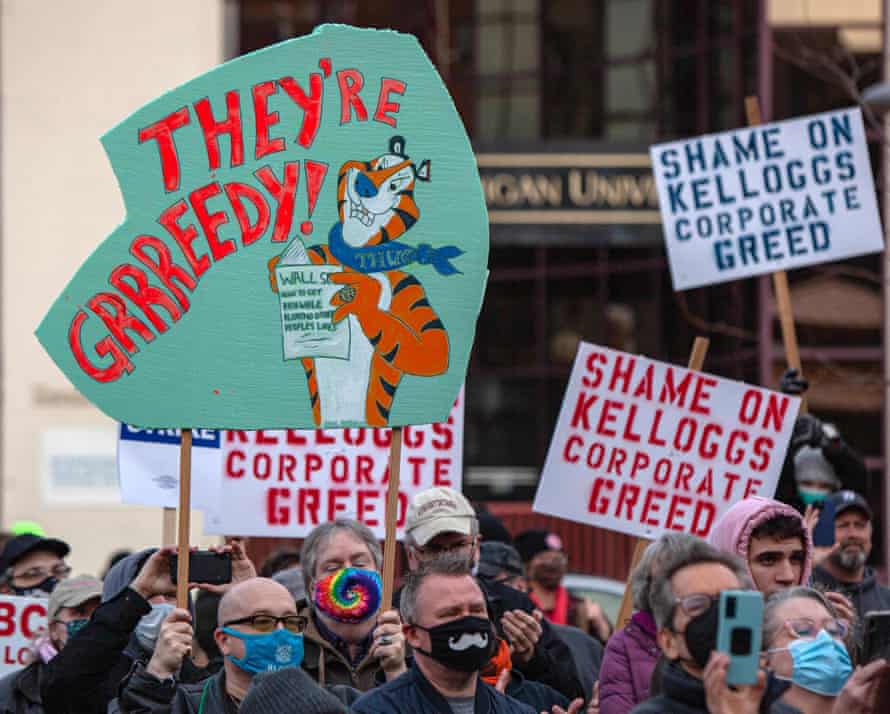Steven Greenhouse
So far, increasingly militant workers are lacking something vital: a leader who can unite them all. Will that change?

‘Public approval for unions is the highest it’s been in more than a half century.’ Photograph: Charlie Neibergall/AP
Mon 3 Jan 2022 11.15 GMT
Throughout 2021, American workers stood up and fought back to an unusual degree. Workers went on strike at Kellogg’s, Nabisco, John Deere, Columbia University and numerous hospitals, while non-union “essential” workers – furious about how they’ve been treated – walked out at supermarkets, warehouses and fast-food restaurants. Workers have sought to unionize at Starbucks, Amazon, even the Art Institute of Chicago. And a record number of Americans have been quitting their jobs each month, more than 4 million monthly, fed up and eager for something better.
Millions of workers are angry – angry that they didn’t get hazard pay for risking their lives during the pandemic, angry that they’ve been forced to work 70 or 80 hours a week, angry that they received puny raises while executive pay soared, angry that they didn’t get paid sick days when they got sick.

‘They are fed up’: US labor on the march in 2021 after years of decline
Out of this comes a question that looms large for America’s workers: will this surge of worker action and anger be a mere flash in the pan or will it be part of a longer-lasting phenomenon? The answer to this important question could turn on whether all this anger and energy are somehow transformed into a larger movement. At least for now, America’s labor leaders seem to be doing very little to tap all this energy and hope and to build it into something bigger and longer lasting. Yes, we are seeing unionization drives at this workplace and that one, but we are not seeing any bigger, broader effort to channel and transform all this worker energy and discontent into a new movement, one perhaps with millions of engaged and energetic nonunion workers, that would work in conjunction with the traditional union movement.
Worker advocates I speak to keep wondering: what are labor leaders waiting for? If not now, when?
In Joe Biden, we have the most pro-union president since Franklin Roosevelt, and public approval for unions is the highest it’s been in more than a half century. For decades, union leaders have said they are eager to reverse labor’s long decline – more than 20% of workers were in unions three decades ago, now just 10% are. Unless unions step up and do something bold, they’ll relegate themselves to continued decline.
Many labor leaders evidently think it’s impossible or improbable to turn this year’s energy and anger into a new movement or a big, new group. But building a movement from scratch isn’t impossible. 350.org was founded in 2008 by several college students and environmentalist author Bill McKibben, and within two years, it organized a mammoth Day of Climate Action with a reported 5,245 actions in 181 countries. After the horrific shootings at Marjorie Stoneman high school in Florida in 2018, a handful of students founded March for Our Lives, and within five weeks, their group had organized nationwide rallies with hundreds of thousands of people calling for gun control. Black Lives Matter also grew into a powerful national movement within a few years. None of these movements were one-shot or one-month affairs – they have become powers to contend with in policy and politics.
So why isn’t the labor movement seizing on this year’s burst of worker energy to build something bigger? I was discussing this with friend who is a professor of labor studies, and she said she thought that most of today’s union leaders were “constitutionally incapable” of building big or being bold and ambitious. She said that after decades of being on the defensive, of being beaten down by hostile corporations, hostile GOP lawmakers and hostile judicial decisions, many labor leaders seem unable to dream big or think outside the box on how to attract large numbers of workers in ways beyond the traditional one-workplace-at-a-time union drives.
But building big and outside the box isn’t impossible for labor. Just look at the Fight for $15. The strategists and SEIU leaders behind it had a vision: they wanted to push the issue of low wages into the national conversation and lift the pay floor for millions of workers. They started small, with walkouts by 200 workers at a dozen fast-food restaurants in New York City, and within two years, they built a powerful national movement that held strikes and protests in hundreds of cities. This movement ultimately got a dozen states to enact a $15 minimum wage, lifting pay for over 20 million workers.
Perhaps some brilliant, visionary workers or worker advocates will step forward to seek to channel this year’s burst of worker anger and energy into a new movement. Social media could certainly help build it, perhaps with the assistance of groups like Coworker.org, which has considerable experience engaging and mobilizing disgruntled rank-and-file workers via the internet.
Mon 3 Jan 2022 11.15 GMT
Throughout 2021, American workers stood up and fought back to an unusual degree. Workers went on strike at Kellogg’s, Nabisco, John Deere, Columbia University and numerous hospitals, while non-union “essential” workers – furious about how they’ve been treated – walked out at supermarkets, warehouses and fast-food restaurants. Workers have sought to unionize at Starbucks, Amazon, even the Art Institute of Chicago. And a record number of Americans have been quitting their jobs each month, more than 4 million monthly, fed up and eager for something better.
Millions of workers are angry – angry that they didn’t get hazard pay for risking their lives during the pandemic, angry that they’ve been forced to work 70 or 80 hours a week, angry that they received puny raises while executive pay soared, angry that they didn’t get paid sick days when they got sick.

‘They are fed up’: US labor on the march in 2021 after years of decline
Out of this comes a question that looms large for America’s workers: will this surge of worker action and anger be a mere flash in the pan or will it be part of a longer-lasting phenomenon? The answer to this important question could turn on whether all this anger and energy are somehow transformed into a larger movement. At least for now, America’s labor leaders seem to be doing very little to tap all this energy and hope and to build it into something bigger and longer lasting. Yes, we are seeing unionization drives at this workplace and that one, but we are not seeing any bigger, broader effort to channel and transform all this worker energy and discontent into a new movement, one perhaps with millions of engaged and energetic nonunion workers, that would work in conjunction with the traditional union movement.
Worker advocates I speak to keep wondering: what are labor leaders waiting for? If not now, when?
In Joe Biden, we have the most pro-union president since Franklin Roosevelt, and public approval for unions is the highest it’s been in more than a half century. For decades, union leaders have said they are eager to reverse labor’s long decline – more than 20% of workers were in unions three decades ago, now just 10% are. Unless unions step up and do something bold, they’ll relegate themselves to continued decline.
Many labor leaders evidently think it’s impossible or improbable to turn this year’s energy and anger into a new movement or a big, new group. But building a movement from scratch isn’t impossible. 350.org was founded in 2008 by several college students and environmentalist author Bill McKibben, and within two years, it organized a mammoth Day of Climate Action with a reported 5,245 actions in 181 countries. After the horrific shootings at Marjorie Stoneman high school in Florida in 2018, a handful of students founded March for Our Lives, and within five weeks, their group had organized nationwide rallies with hundreds of thousands of people calling for gun control. Black Lives Matter also grew into a powerful national movement within a few years. None of these movements were one-shot or one-month affairs – they have become powers to contend with in policy and politics.
So why isn’t the labor movement seizing on this year’s burst of worker energy to build something bigger? I was discussing this with friend who is a professor of labor studies, and she said she thought that most of today’s union leaders were “constitutionally incapable” of building big or being bold and ambitious. She said that after decades of being on the defensive, of being beaten down by hostile corporations, hostile GOP lawmakers and hostile judicial decisions, many labor leaders seem unable to dream big or think outside the box on how to attract large numbers of workers in ways beyond the traditional one-workplace-at-a-time union drives.
But building big and outside the box isn’t impossible for labor. Just look at the Fight for $15. The strategists and SEIU leaders behind it had a vision: they wanted to push the issue of low wages into the national conversation and lift the pay floor for millions of workers. They started small, with walkouts by 200 workers at a dozen fast-food restaurants in New York City, and within two years, they built a powerful national movement that held strikes and protests in hundreds of cities. This movement ultimately got a dozen states to enact a $15 minimum wage, lifting pay for over 20 million workers.
Perhaps some brilliant, visionary workers or worker advocates will step forward to seek to channel this year’s burst of worker anger and energy into a new movement. Social media could certainly help build it, perhaps with the assistance of groups like Coworker.org, which has considerable experience engaging and mobilizing disgruntled rank-and-file workers via the internet.
In Joe Biden, we have the most pro-union president since Franklin Roosevelt
For many workers, a big new group or movement could be a waystation toward unionizing: helping educate and mobilize workers to unionize, guiding them on next steps and what their rights are, and promising a pool of ready support if they seek to unionize. This new group or movement could send out bulletins telling members how they could help other workers in their community or nearby communities – perhaps help unionization drives at Amazon or Starbucks or strikers at Kellogg’s or Warrior Met Coal in Alabama or food delivery workers who are cheated out of tips and don’t have access to bathrooms.
Members of this new group could be called on to protest outside the offices of members of Congress or state lawmakers about myriad issues, perhaps raising the federal minimum wage or enacting paid family leave or the Protecting the Right to Organize Act. Or they could join rallies for voting rights or immigrant rights or against police abuses or to combat global warming.
Working America, an arm of the AFL-CIO, does some of this, mainly urging its members to vote and to contact lawmakers. To truly help reverse labor’s decline and capitalize on today’s worker anger, much more will be needed – an organization that is far more connected to workers and does far more organizing, protesting and mobilizing.
America’s labor movement is terribly balkanized, with many unions engaged in turf battles and upset that another union has (perhaps) stepped into its territory. As a result, they too often find it hard to work together. But if America’s unions are serious about wanting to strengthen worker power and reverse labor’s decline, it’s time to put past divisions behind them and figure out how to build back something bigger.
There are three main reasons that America’s labor movement has declined: first, corporate America’s fierce resistance to unions, second, the decades-long slide in factory jobs, and, third, the Republican party’s decades-long fight to weaken unions and make it tougher to unionize.
But there’s another factor behind labor’s decline that is rarely discussed – many labor leaders don’t do nearly enough to inspire workers and expand the union movement. Today’s workers could use some vigorous, visionary leaders like Mother Jones, Sidney Hillman, John L Lewis and A Philip Randolph to lead and inspire, and build something bigger. Perhaps many union leaders haven’t been hearing what I often hear from rank-and-file union members: “Lead or get out of the way.”
Steven Greenhouse is a journalist and author, focusing on labor and the workplace. He is the author of Beaten Down, Worked Up: The Past, Present, and Future of American Labor
Our new year’s resolution for 2022: to rise up and fight back
Corporate greed and class warfare are crushing working people. No one is going to save us – we need to rise up together

‘Working people all over the country, with extraordinary courage and determination, are taking on corporate greed, and they are winning.’ Photograph: Scott Olson/Getty Images


Bernie Sanders is a US senator and the chair of the Senate budget committee. He represents the state of Vermont
Corporate greed and class warfare are crushing working people. No one is going to save us – we need to rise up together

‘Working people all over the country, with extraordinary courage and determination, are taking on corporate greed, and they are winning.’ Photograph: Scott Olson/Getty Images
Bernie Sanders
Tue 4 Jan 2022
As we begin the year 2022, in these unprecedented times, I know it’s easy to give in to despair.
We are facing a raging pandemic with seemingly no end in sight. We are rapidly moving toward oligarchy and while income and wealth inequality grows, millions struggle to obtain the basic necessities of life. We have a dysfunctional healthcare system with more than 84 million uninsured or underinsured and nearly one out of four unable to afford prescription drugs. Climate change is ravaging the planet and systemic racism and other forms of bigotry continue to eat away at the fabric of our society. We have a corrupt political system in which corporate money buys elections and a mainstream media that largely ignores the pain that ordinary people experience.
And, in the midst of all this, Republicans across the country are working overtime trying to undermine democracy by making it harder for people of color, young people and those who oppose them to vote in our next elections.
In other words, the challenges we face are enormous and it is easy to understand why many may fall into depression and cynicism. This is a state of mind, however, that we must resist – not only for ourselves but for our kids and future generations. The stakes are just too high. Despair is not an option. We must stand up and fight back.
Here is some good news: working people all over the country are taking on corporate greed and they are winning
And here is some very good news. While the corporate-owned media may not be actively reporting it, working people all over the country, with extraordinary courage and determination, are taking on corporate greed, and they are winning.
Workers at John Deere waged their first strike in more than three decades, stayed on the picket lines and eventually won a contract with strong wage increases, a ratification bonus and improved health insurance.
Striking nurses in Buffalo won raises that moved all workers to at least $15 an hour and a reduction in staff shortages. These nurses fought not only for themselves, but their patients – and they won.
Kaiser Permanente healthcare workers won a major victory after rejecting a contract that would have given new workers lower wages and benefits.
Nabisco workers, struggling against forced overtime, inadequate wages and pensions, a two-tier health system and the outsourcing of jobs, went on strike and won. Once again we saw workers fighting not just for themselves, but for the next generation of workers.
More than 1,400 Kellogg’s workers in Michigan, Tennessee, Pennsylvania and Nebraska went on strike for months and won, fighting back against a plan to give new workers lower wages and benefits.
Starbucks employees in upstate New York, for the very first time, organized a union shop in a fight against a giant corporation that did just about everything it could to stop them.
Those are just some of the inspiring efforts that took place last year. Let me tell you about what’s happening right now as workers continue to stand up to some of the most powerful corporate interests in the country.
In Huntington, West Virginia, 450 steelworkers at the Special Metals company have been engaged in a major strike for almost 100 days. Special Metals is a profitable company owned by Warren Buffett’s Berkshire Hathaway. Buffett, of course, is one of the richest people in the world, with wealth of over $109bn.
While Special Metals made $1.5bn in profits last year and Mr Buffett became over $40bn richer during the pandemic, executives at this company offered workers an outrageous and insulting contract that includes a zero pay increase for this year, and a totally unacceptable 1% pay raise next year, while quadrupling healthcare premiums and reducing vacation time.
Tue 4 Jan 2022
As we begin the year 2022, in these unprecedented times, I know it’s easy to give in to despair.
We are facing a raging pandemic with seemingly no end in sight. We are rapidly moving toward oligarchy and while income and wealth inequality grows, millions struggle to obtain the basic necessities of life. We have a dysfunctional healthcare system with more than 84 million uninsured or underinsured and nearly one out of four unable to afford prescription drugs. Climate change is ravaging the planet and systemic racism and other forms of bigotry continue to eat away at the fabric of our society. We have a corrupt political system in which corporate money buys elections and a mainstream media that largely ignores the pain that ordinary people experience.
And, in the midst of all this, Republicans across the country are working overtime trying to undermine democracy by making it harder for people of color, young people and those who oppose them to vote in our next elections.
In other words, the challenges we face are enormous and it is easy to understand why many may fall into depression and cynicism. This is a state of mind, however, that we must resist – not only for ourselves but for our kids and future generations. The stakes are just too high. Despair is not an option. We must stand up and fight back.
Here is some good news: working people all over the country are taking on corporate greed and they are winning
And here is some very good news. While the corporate-owned media may not be actively reporting it, working people all over the country, with extraordinary courage and determination, are taking on corporate greed, and they are winning.
Workers at John Deere waged their first strike in more than three decades, stayed on the picket lines and eventually won a contract with strong wage increases, a ratification bonus and improved health insurance.
Striking nurses in Buffalo won raises that moved all workers to at least $15 an hour and a reduction in staff shortages. These nurses fought not only for themselves, but their patients – and they won.
Kaiser Permanente healthcare workers won a major victory after rejecting a contract that would have given new workers lower wages and benefits.
Nabisco workers, struggling against forced overtime, inadequate wages and pensions, a two-tier health system and the outsourcing of jobs, went on strike and won. Once again we saw workers fighting not just for themselves, but for the next generation of workers.
More than 1,400 Kellogg’s workers in Michigan, Tennessee, Pennsylvania and Nebraska went on strike for months and won, fighting back against a plan to give new workers lower wages and benefits.
Starbucks employees in upstate New York, for the very first time, organized a union shop in a fight against a giant corporation that did just about everything it could to stop them.
Those are just some of the inspiring efforts that took place last year. Let me tell you about what’s happening right now as workers continue to stand up to some of the most powerful corporate interests in the country.
In Huntington, West Virginia, 450 steelworkers at the Special Metals company have been engaged in a major strike for almost 100 days. Special Metals is a profitable company owned by Warren Buffett’s Berkshire Hathaway. Buffett, of course, is one of the richest people in the world, with wealth of over $109bn.
While Special Metals made $1.5bn in profits last year and Mr Buffett became over $40bn richer during the pandemic, executives at this company offered workers an outrageous and insulting contract that includes a zero pay increase for this year, and a totally unacceptable 1% pay raise next year, while quadrupling healthcare premiums and reducing vacation time.

Striking Kellogg workers in Battle Creek, Michigan, in December. Photograph: Seth Herald/AFP/Getty Images
Sadly, the corporate greed that is going on in West Virginia is not an aberration. In Santa Fe Springs, California, about 100 bakery workers, who make cakes for Baskin Robbins, Safeway and Cold Stone Creamery, are on strike against the appropriately named Rich Products Corporation at the Jon Donaire Desserts production plant. About 75% of these employees are Latina women who are often forced into mandatory overtime with little to no notice and sometimes work up to 16 hours a day.
This is a company that made $4bn in revenue last year. During the pandemic, Bob Rich, the majority owner of Rich Products, increased his wealth by more than $2bn. While the workers he employs barely make more than California’s minimum wage, Mr Rich currently has a net worth of more than $7.5bn. Yet, despite his billions in wealth, the “best and final offer” Mr Rich has put on the table for his workers is an insulting $1-an-hour wage increase. That is pathetic.
But it’s also not unusual in the world of corporate greed. In Brookwood, Alabama, about 1,100 workers at Warrior Met Coal have been on strike since April. Just like the bakery workers in California and the steelworkers in West Virginia, these are workers who also have worked as many as seven days a week and up to 16 hours per day.

In 2016, under great pressure to keep the company afloat and keep jobs in their community, these coalminers agreed to a $6-an-hour pay cut – more than 20% of their average salary – and a substantial reduction in their healthcare and retirement benefits as part of a restructuring deal made by Wall Street vulture funds like Blackstone and Apollo.
Meanwhile, the executives at Warrior Met and their Wall Street investors made out like bandits. Since 2017, Warrior Met has rewarded $1.4bn in dividends to its wealthy shareholders while handing out bonuses of up to $35,000 to its executives. Yet, while the company has returned to profitability, Warrior Met has offered its workers a measly $1.50 raise over 5 years and has refused to restore the healthcare and pension benefits that were taken away.
The struggles that these workers are experiencing are not unique. There are millions of other Americans in exactly the same position – people who have to fight tooth-and-nail against wealthy and powerful corporate interests for decent wages, healthcare, pensions and safe working conditions. And let’s be clear. Class warfare in this country is intensifying. Greed is on the rise.
The greatest weapon our opponents have is their ability to create a culture that makes us feel hopeless and diminishes the strength of solidarity
What history has always taught us is that real change never takes place from the top on down. It is always occurs from the bottom on up. That is the history of the labor movement, the civil rights movement, the women’s movement, the environmental movement and the gay rights movement. That is the history of every effort that has brought about transformational change in our society.
And that is the struggle we must intensify today. At a time when the demagogues want to divide us up based on the color of our skin, where we were born, our religion or our sexual orientation, we must do exactly the opposite. We must bring people together around a progressive agenda. We must educate, organize and build an unstoppable grassroots movement that helps create the kind of nation we know we can become. One that is based on the principles of justice and compassion, not greed and oligarchy.
The greatest weapon our opponents have is not just their unlimited wealth and power. It is their ability to create a culture that makes us feel weak and hopeless and diminishes the strength of human solidarity.
And here is our new year’s resolution. Like the thousands of workers who stood up and fought courageously in 2021, we will do the same. No one individual is going to save us. We must rise up together.
Happy new year.
Sadly, the corporate greed that is going on in West Virginia is not an aberration. In Santa Fe Springs, California, about 100 bakery workers, who make cakes for Baskin Robbins, Safeway and Cold Stone Creamery, are on strike against the appropriately named Rich Products Corporation at the Jon Donaire Desserts production plant. About 75% of these employees are Latina women who are often forced into mandatory overtime with little to no notice and sometimes work up to 16 hours a day.
This is a company that made $4bn in revenue last year. During the pandemic, Bob Rich, the majority owner of Rich Products, increased his wealth by more than $2bn. While the workers he employs barely make more than California’s minimum wage, Mr Rich currently has a net worth of more than $7.5bn. Yet, despite his billions in wealth, the “best and final offer” Mr Rich has put on the table for his workers is an insulting $1-an-hour wage increase. That is pathetic.
But it’s also not unusual in the world of corporate greed. In Brookwood, Alabama, about 1,100 workers at Warrior Met Coal have been on strike since April. Just like the bakery workers in California and the steelworkers in West Virginia, these are workers who also have worked as many as seven days a week and up to 16 hours per day.

In 2016, under great pressure to keep the company afloat and keep jobs in their community, these coalminers agreed to a $6-an-hour pay cut – more than 20% of their average salary – and a substantial reduction in their healthcare and retirement benefits as part of a restructuring deal made by Wall Street vulture funds like Blackstone and Apollo.
Meanwhile, the executives at Warrior Met and their Wall Street investors made out like bandits. Since 2017, Warrior Met has rewarded $1.4bn in dividends to its wealthy shareholders while handing out bonuses of up to $35,000 to its executives. Yet, while the company has returned to profitability, Warrior Met has offered its workers a measly $1.50 raise over 5 years and has refused to restore the healthcare and pension benefits that were taken away.
The struggles that these workers are experiencing are not unique. There are millions of other Americans in exactly the same position – people who have to fight tooth-and-nail against wealthy and powerful corporate interests for decent wages, healthcare, pensions and safe working conditions. And let’s be clear. Class warfare in this country is intensifying. Greed is on the rise.
The greatest weapon our opponents have is their ability to create a culture that makes us feel hopeless and diminishes the strength of solidarity
What history has always taught us is that real change never takes place from the top on down. It is always occurs from the bottom on up. That is the history of the labor movement, the civil rights movement, the women’s movement, the environmental movement and the gay rights movement. That is the history of every effort that has brought about transformational change in our society.
And that is the struggle we must intensify today. At a time when the demagogues want to divide us up based on the color of our skin, where we were born, our religion or our sexual orientation, we must do exactly the opposite. We must bring people together around a progressive agenda. We must educate, organize and build an unstoppable grassroots movement that helps create the kind of nation we know we can become. One that is based on the principles of justice and compassion, not greed and oligarchy.
The greatest weapon our opponents have is not just their unlimited wealth and power. It is their ability to create a culture that makes us feel weak and hopeless and diminishes the strength of human solidarity.
And here is our new year’s resolution. Like the thousands of workers who stood up and fought courageously in 2021, we will do the same. No one individual is going to save us. We must rise up together.
Happy new year.

Bernie Sanders is a US senator and the chair of the Senate budget committee. He represents the state of Vermont
No comments:
Post a Comment